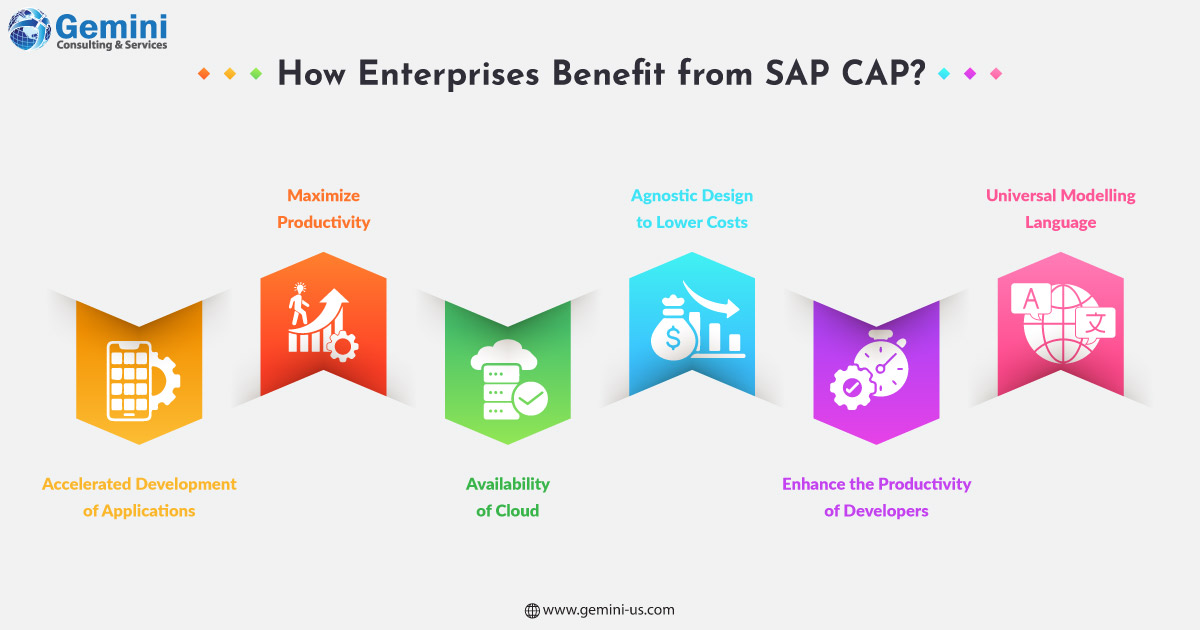It is necessary for organizations to streamline the process of application development which will in turn lead to a streamlined development process and reduced maintenance.
According to Forbes, most software engineers spend half their workday on what’s known as toil — tedious, repetitive tasks like testing and shipping code or waiting for approvals. It’s like throwing a dollar in the trash for every dollar spent on development.
The SAP Cloud Application Programming (CAP) model is an innovative framework that helps address the challenges of conventional application development by providing a robust set of languages, libraries, and tools to build enterprise-grade applications. SAP Cloud Application Programming Model provides developers with an easy way to create and deploy robust applications that can be used across the entire SAP environment.
With its powerful application tools and development paradigms, developers can build end-to-end applications with minimal coding, and ensure that each cloud-native application scales to meet business needs within the SAP platform.

Key Components of the SAP CAP Model
- Software Development Kits (SDKs) for services across the SAP landscape help users offer, manage, and consume services through both synchronous and asynchronous APIs, including Node.js and Java libraries. Using this feature SAP users can leverage out-of-the-box integration capabilities to connect lower-level services, like on and off-boarding processes and authentication flows. This helps improve overall connectivity between applications and interfaces across the SAP system.
- Core Data Services (CDS) is SAP’s data modeling infrastructure that helps manage CAP-based projects and adapt solutions to meet the needs of the businesses’ rapidly changing cloud technologies across the entire enterprise. It simplifies service definitions and data models for teams across the organization by managing data models and queries in plain object notations for easier user access.
- The SAP Cloud Application Programming Model helps integrate other components across the SAP system, including the SAP Business Application Studio (BAS), SAP HANA database, and SAP Fiori elements. These functional integrations equip SAP users with the tools needed to model their database schema, service interface, and other individual applications efficiently across teams.
Leveraging SAP Cloud Application Programming (CAP) offers capabilities to plan, create, manage, and deploy new applications across your organization. Gemini Consulting & Services is well-placed to help enterprises integrate CAP functionality with other components of the SAP system. Contact us to know the services offered by us.

- Accelerated Development of Applications: With traditional architecture, developers often encounter the pressure to enhance efforts to add enterprise qualities to their applications. With CAP, the process is simplified due to the availability of an opinionated framework based on industry best practices. This helps developers accelerate application development and easily incorporate enterprise capabilities. This brings the amount of boilerplate code while improving application quality, all at a lower cost.
- Maximize Productivity: SAP CAP can jumpstart development with minimal setup helping developers build applications with ease and iterate them rapidly using mocked production services. CAP’s flexibility allows developers to add components and features based on need. This agile approach empowers developers to focus on their domain expertise This also fosters close collaboration between developers and domain experts.
- Availability of Cloud: CAP provides intrinsic cloud qualities, such as multitenancy, extensibility, security, scalability, etc in a platform-agnostic manner thus allowing applications to adapt to various cloud platforms with ease. CAP leverages a mix of proven open-source technologies and SAP’s proprietary solutions, helping developers build robust and scalable cloud-native applications catering to the demands of modern enterprises.
- Agnostic Design to Lower Costs: CAP adopts higher-level concepts and APIs that abstract low-level platform features and protocol, future-proofing applications and avoiding vendor lock-ins. Thus, applications built with CAP can easily adapt to emerging technologies or platforms without much change to the application code. CAP’s agnostic design safeguards investments and lends the flexibility to choose tools, technologies, and architecture patterns that best suit a given organization’s needs.
- Enhance the Productivity of Developers: CAP provides opinionated guidance while bearing in mind the challenges faced by developers. Developers have the freedom to choose their preferred tools, technologies, and architecture patterns using CAP’s best practices to their best advantage. CAP offers out-of-the-box support for SAP Fiori and SAP HANA, but developers can also choose other UI technologies or databases by introducing new integrations. CAP’s dedicated tool support in applications such as SAP Business Application Studio, Visual Studio Code, and Eclipse further accelerates developer productivity.
- Universal Modelling Language: CAP introduces key concepts based on the Declarative Paradigms and Service-Centric Paradigms. They provide a universal modeling language for domain models and service definitions. This helps developers to capture intent first instead of relying on imperative coding. The focus on being service-centric emphasizes the right notions of services, events, and queries thereby allowing developers to build scalable and resilient applications.
Additional Advantages
- The modular architecture of CAP is designed to enable technical SAP developers to separate complex applications into smaller, more manageable components. This makes it easier to develop, test, manage, and maintain new as well as existing applications.
- The SAP Cloud Application Programming Model is built to be scalable, and it provides a plethora of integration options. It is hence ideal for building cloud-native applications that can handle large amounts of data and users to further accommodate business growth and change over time.
- Developers can focus on building the business logic of their applications as against handling complexities of the core infrastructure of each application.
- SAP CAP provides a variety of flexible deployment options and allows developers and other SAP users to run applications on-premise or in the cloud. It also supports several database types, and hence it is easy to integrate it with new and existing systems.



